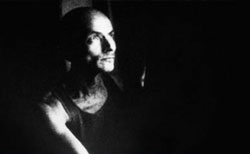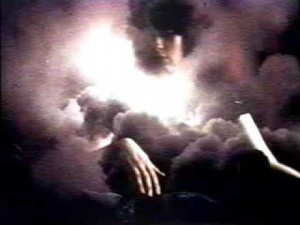The Articulation of Trauma in Moving Image Art by Dirk De Bruyn (excerpt, PhD thesis, 2012)
Tom is Canadian Mike Hoolboom’s biography of filmmaker Tom Chomont and his city, New York and recycles excerpts of his films such as Phases of the Moon (dir. Tom Chomont, 1968) and Sadistic Self Portrait (dir. Tom Chomont, 1994). Its visual imagery processes directly to the audience the everyday traumas re-counted on the soundtrack. Chomont tells of his struggle with HIV and Parkinson’s disease and disarmingly recounts confronting memories of infanticide, incest, fetishism and death. These revelations are processed through an anthropology of techniques, pulled out of Hoolboom’s lifelong immersion in fringe film, bringing to bear layered photos, home movies, video, appropriated archival and found footage and images directly out of the video rental store, to construct a cathartic visual processing machine. Kroker’s ideas on panic bodies and excremental culture permeate both the video’s structure and content. As well as McLuhan, other Canadian thinkers on technology, George Grant and McLuhan’s mentor, Harold Innis, shape both Hoolboom’s and Kroker’s thinking to evolve a position syncing with the critical position materialist film retrieves within digital technology described here. For Kroker, Harold Innis: ‘seeks to preserve some critical space in Canadian discourse for the recovery of an authentic sense of time’ (Kroker 1985: 124) Linking to Gidal’s work on duration. Hoolboom’s Tom examines the erasure and loss of both Chomont’s body and moving image practice and recovers time by simultaneously re-casting a resilient personal form of digital moviemaking out of popular media detritus. Both Kroker and Hoolboom resource George Grant’s invocation to preserve a Canadian identity in the face of the dominant technological monolith of the United States of America: ‘only in listening for the intimations of deprival can we live critically in that dynamo’ (Grant 1969: 142). This invocation and Hoolboom’s practice speaks to Elsaesser’s ‘different kind of hermeneutics’ (Elsaesser 2001: 196), required to break through the surface of Flusser’s ‘technical image’.
It is through its ability to articulate trauma that I have argued for a role for materialist film in unpacking that ‘technical image’ dominating that public space ushered in by digital media, utilising Kroker’s ‘panic bodies’ and Schivelbusch’s commentary on the traumatic impact of an earlier period of rapid technological change. Though distinct, this linking of materialist film to digital media through trauma may mark a transitory historic moment. The greater reliance on SAM (Situational Accessible Memory) in an age of simultaneous information flow need not continue to be experienced as traumatic. Further research or analysis may reveal if the traumatic impact of new technology performed on Kroker’s ‘panic bodies’ describes an intermediate period of stress on a sensory cluster undergoing metamorphosis before, as Laurel puts it: ‘we go to sleep again’ (Laurel 1994:125). Hoolboom’s Tom, informed by panic and extreme personal experience already reprocesses this material to sublime effect. According to Schivelbusch the stress of negotiating the new technology of train travel was eventually retrained or rewired through a ‘dispersal of attention’ (Schivelbusch 1986 :68-69). McLuhan’s fourth law of media supports this view. It states that when a technology is ‘pushed to the limits of its potential the new form will tend to reverse what have been its original characteristics’ (McLuhan & McLuhan 1988: 99). Trauma becomes contemplation? ‘Breakdown becomes breakthrough’ (McLuhan & McLuhan 1988: 108). McLuhan’s third law, where the content of one medium is another medium, is also of interest here describing materialist film’s retrieval and textual analysis’s containment within digital technology: ‘an old ground seen as figure through a new ground’ (McLuhan & McLuhan 1988: 103)

